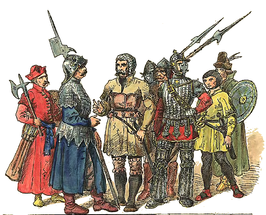
Albert of Prussia was a German prince who was the 37th grand master of the Teutonic Knights and, after converting to Lutheranism, became the first ruler of the Duchy of Prussia, the secularized state that emerged from the former Monastic State of the Teutonic Knights. Albert was the first European ruler to establish Lutheranism, and thus Protestantism, as the official state religion of his lands. He proved instrumental in the political spread of Protestantism in its early stage, ruling the Prussian lands for nearly six decades (1510–1568).

The Teutonic Order is a Catholic religious institution founded as a military society c. 1190 in Acre, Kingdom of Jerusalem. The Order of Brothers of the German House of Saint Mary in Jerusalem was formed to aid Christians on their pilgrimages to the Holy Land and to establish hospitals. Its members have commonly been known as the Teutonic Knights, having historically served as a crusading military order for supporting Catholic rule in the Holy Land and the Northern Crusades during the Middle Ages, as well as supplying military protection for Catholics in Eastern Europe.
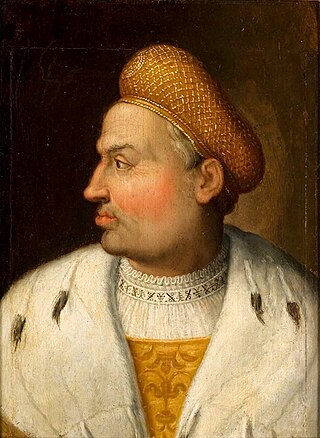
Sigismund I the Old was King of Poland and Grand Duke of Lithuania from 1506 until his death in 1548. Sigismund I was a member of the Jagiellonian dynasty, the son of Casimir IV and younger brother of Kings John I Albert and Alexander I Jagiellon. He was nicknamed "the Old" in later historiography to distinguish him from his son and successor, Sigismund II Augustus. Before ascending to the Polish and Lithuanian thrones, he was Duke of Głogów from 1499, Duke of Opava from 1501, and governor of Silesia from 1504 on behalf of his brother, King Vladislaus II of Bohemia and Hungary.

Royal Prussia or Polish Prussia became a province of the Crown of the Kingdom of Poland, which was annexed following the imposed Second Peace of Toruń (1466) from territory in Pomerelia and western Prussia which had been part of the State of the Teutonic Order. Royal Prussia retained its autonomy, governing itself and maintaining its own laws, customs, rights and German language for the German minority and Polish language for the Polish majority.
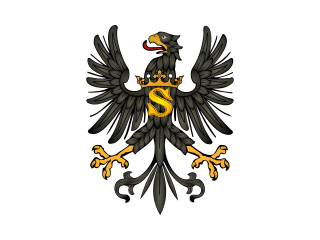
The Duchy of Prussia or Ducal Prussia was a duchy in the region of Prussia established as a result of secularization of the Monastic Prussia, the territory that remained under the control of the State of the Teutonic Order until the Protestant Reformation in 1525.

The Prussian Homage or Prussian Tribute was the formal investiture of Albert, Duke of Prussia (1490-1568), with his Duchy of Prussia as a fief of the Kingdom of Poland that took place on 10 April 1525 in the then capital of Kraków, Kingdom of Poland. This ended the rule of the Teutonic Order in Prussia, which became a secular Protestant state.

The State of the Teutonic Order was a theocratic state located along the southeastern shore of the Baltic Sea in northern Europe. It was formed by the knights of the Teutonic Order during the early 13th century Northern Crusades in the region of Prussia. In 1237, the Livonian Brothers of the Sword merged with the Teutonic Order of Prussia and became known as its branch – the Livonian Order. At its greatest territorial extent during the early 15th century, the State encompassed Chełmno Land, Courland, Gotland, Livonia, Estonia, Neumark, Pomerelia, Prussia and Samogitia.

The Polish–Lithuanian–Teutonic War, also known as the Great Teutonic War, occurred between 1409 and 1411 between the Teutonic Knights and the allied Kingdom of Poland and Grand Duchy of Lithuania. Inspired by the local Samogitian uprising, the war began with a Teutonic invasion of Poland in August 1409. As neither side was ready for a full-scale war, Wenceslaus IV of Bohemia brokered a nine-month truce.

The Treaty of Kraków was signed on 8 April 1525 between the Kingdom of Poland and the Grand Master of the Teutonic Knights. It officially ended the Polish–Teutonic War (1519-1521)

The Treaty of Melno or Treaty of Lake Melno was a peace treaty ending the Gollub War. It was signed on 27 September 1422, between the Teutonic Knights and an alliance of the Kingdom of Poland and the Grand Duchy of Lithuania at Lake Melno, east of Graudenz (Grudziądz). The treaty resolved territorial disputes between the Knights and Lithuania regarding Lithuania Minor and Samogitia, which had dragged on since 1382, and determined the Prussian–Lithuanian border, which afterwards remained unchanged for about 500 years. A portion of the original border survives as a portion of the modern border between the Republic of Lithuania and Kaliningrad Oblast, Russia, making it one of the oldest and most stable borders in Europe.

This is the 1422 Polish-Teutonic War. For a list of all Polish-German Wars, see Polish-German Wars.
This is the 1414 Polish-Teutonic War. For a list of all Polish-German Wars, see Polish-German Wars.

Polish–Teutonic Wars refer to a series of conflicts that took place between the Kingdom of Poland and the Teutonic Order, a medieval German military order with roots in the Baltic region. These wars occurred primarily during the 14th and 15th centuries and were characterized by territorial disputes, political maneuvering, and religious differences.
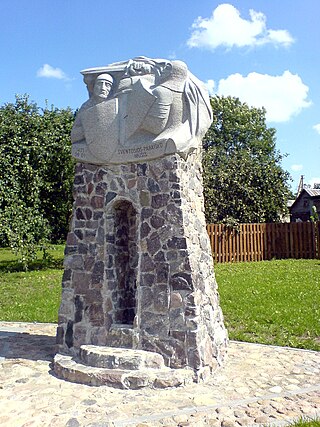
The Lithuanian Civil War of 1432–1438 was a war of succession to the throne of the Grand Duchy of Lithuania, after Vytautas the Great died in 1430 without leaving an heir. The war was fought on the one side by Švitrigaila, allied with the Teutonic Knights, and on the other by Sigismund Kęstutaitis, backed by the Kingdom of Poland. The war threatened to sever the Union of Krewo, the personal union between Poland and Lithuania. Švitrigaila's alliance with the Grand Master of the Teutonic Order, Paul von Rusdorf, launched the Polish–Teutonic War (1431–1435) but failed to secure victory for Švitrigaila.

The Prussian Crusade was a series of 13th-century campaigns of Roman Catholic crusaders, primarily led by the Teutonic Knights, to Christianize under duress the pagan Old Prussians. Invited after earlier unsuccessful expeditions against the Prussians by Christian Polish princes, the Teutonic Knights began campaigning against the Prussians, Lithuanians and Samogitians in 1230. By the end of the century, having quelled several Prussian uprisings, the Knights had established control over Prussia and administered the conquered Prussians through their monastic state, eventually erasing the Prussian language, culture and pre-Christian religion by a combination of physical and ideological force. Some Prussians took refuge in neighboring Lithuania.
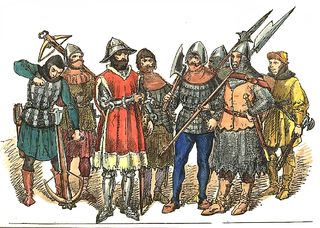
This is the 1454-1466 Polish-Teutonic War. For a list of all Polish-German Wars, see Polish-German Wars.
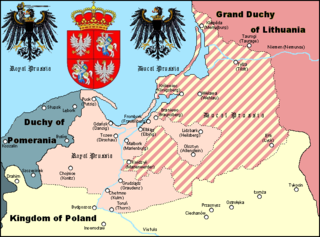
The siege of Allenstein or the siege of Olsztyn took place from January 1521 to February 1521, during the Polish–Teutonic War (1519–1521).

The rule of the Jagiellonian dynasty in Poland between 1386 and 1572 spans the Late Middle Ages and the Early Modern Period in European history. The Lithuanian Grand Duke Jogaila founded the dynasty; his marriage to Queen Jadwiga of Poland in 1386 strengthened an ongoing Polish–Lithuanian union. The partnership brought vast territories controlled by the Grand Duchy of Lithuania into Poland's sphere of influence and proved beneficial for both the Polish and Lithuanian people, who coexisted and cooperated in one of the largest political entities in Europe for the next four centuries.
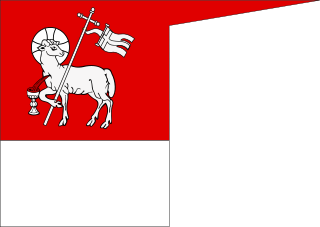
The Prince-Bishopric of Warmia was a semi-independent ecclesiastical state, ruled by the incumbent ordinary of the Warmia see and comprising one third of the then diocesan area. The Warmia see was a Prussian diocese under the jurisdiction of the Archbishopric of Riga that was a protectorate of the Monastic state of the Teutonic Knights (1243–1464) and a protectorate and part of the Kingdom of Poland—later part of the Polish–Lithuanian Commonwealth (1464–1772), confirmed by the Peace of Thorn in 1466. The other two thirds of the diocese were under the secular rule of the Teutonic Knights until 1525 and Ducal Prussia thereafter, both entities also being a protectorate and part of Poland from 1466.
The Compromise of Thorn on 5th of April, 1521, was a peace agreement between the Teutonic Order and the Kingdom of Poland. It was a direct response to the Polish–Teutonic War, a feud that had been going on between both countries for about two years.
